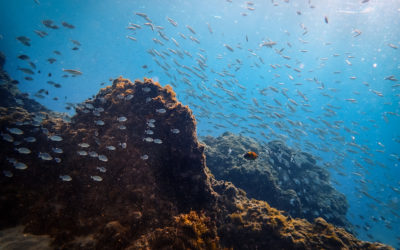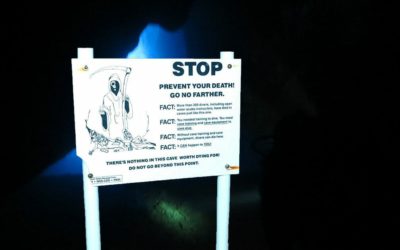Good buoyancy starts at the surface, even before gearing up. It starts with the decision about the amount of weight you are planning to dive with. Why? Starting a dive properly weighted is probably the most crucial contributing factor of performing good buoyancy while diving. If you begin your dive over-weighted, it won’t matter how much you learnt about buoyancy, you won’t be able to control yourself.
Click here to learn about the bad habit of over-weighting.
To find out how much lead you need to be adequate weighted, we undertake a simple buoyancy check. To make practice of it under various conditions it allows us to learn about ourselves as divers and how those conditions may affect our buoyancy. Anything from changing the configuration of our gear to different water conditions might have impact on our buoyancy and its control. The more you practise, the better you will know yourself.
How do to do a buoyancy check?
Like most things in diving, there’s more than only one way. What may work for one person, may not work for others. One method follows as such:
With a completely deflated BCD and half full lungs you should float at eye level.
• If you deflate your BCD and your head sinks beneath the surface, you have over-weighted yourself.
• If the water level remains at your chest with an empty BCD, you should consider additional weight.
That sounds simple, right? The next time you dive, ask your buddy to perform a buoyancy check before descending. Very quickly you will have an idea whether you are diving with enough or too much weight. Now that you’ve done your first buoyancy check, let’s add a bit more knowledge:
We undertake a simple buoyancy check. To make practice of it under various conditions allows us to learn about ourselves as divers and how those conditions may affect our buoyancy.
1 – Full Tank vs. Empty Tank
A full tank generally weighs around 2 kg more than an empty one. Therefore deciding whether we do a buoyancy check with a full or an empty tank will affect how much weight we need. Some divers prefer to start the dive a bit heavier than they initially should be. By the end of the dive, with a reserve of 50 bar, they should be perfectly weighted for a relaxed safety stop. Other divers might prefer a different approach, which is to maintain perfect buoyancy throughout the dive, but perhaps finishing a bit more positively buoyant. What’s the correct decision? Well, both!
If you dive with the expectation of finishing with 50 bar you might want to take into consideration the 2 kg of weight loss. Also consider this weight difference, if you are not comfortable feeling a bit floaty towards the end of a dive.
However, if you usually finish your dive with a significant quantity of gas remaining in your tank (such as 100 bar), you’re probably unlikely to notice that you’re not as negatively buoyant as you were at the beginning of the dive. Some people prefer to enjoy 45 minutes of being weightless and only feeling slightly more buoyant during the safety stop. Now that we know those different options, here’s how we can apply some changes to the buoyancy check:
• Do the check with a nearly empty tank, in other words, simulate the same air conditions that you would have at the end of the dive.
• Fully fill your lungs, instead of only half and see, if you float at eye-level. This means that you will require slightly more weight and it helps to simulate a task-loading scenario during the safety stop (when you are most likely to encounter any issues).
Starting a dive properly weighted is perhaps the most crucial contributing factor to dive with good buoyancy.
2 – The deeper you dive, the more negatively buoyant you will be
As you dive deeper, you may feel over-weighted. This may be a reason why some divers prefer to remain a bit more positive buoyant at the surface, in order to enjoy perfect buoyancy at depth.
If you choose to weight yourself slightly less negatively, be aware that the first 2 metres of your descent may be more difficult. Remember that you are a bit buoyant at the surface, but while descending you will become heavier. It is a border of 2-3 m and afterwards you should continue descending without troubles. Here are some tips that you can combine to help you descend past those initial 2 metres:
Use gravity to sink faster
Try to empty your lungs. Once they are empty, kick up strongly once and let gravity send you down again. This will make you sink a bit faster and you make advantage of your inertia to reach the level where you don’t float. At this point you should breath normally.
Breathe for sinking
Focus on exhaling. You will start to sink. If you breathe normally, you may float back to the surface. Instead, focus on lengthening your exhalation to avoid floating up to the surface. Wait one or two seconds with your lungs empty and repeat once more, if necessary.
Swim down with a back kick
If you know the technique of swimming backwards, it is a good moment to use it. If you are in a vertical position and you swim in reverse, you will help to pull yourself down.
Simply swim down
The most common technique employed. Point your head down and swim. Once you reach a comfortable depth, relax and maintain a horizontal position or go back to vertical head up position.
It is highly recommended that you spend some time trying out different scenarios and environments. Perform various options of a buoyancy check and decide what is best for you. Learning about yourself and how you can improve as a diver requires time and practice. The good news are that to practice means being underwater and having fun! Go to your next step: Perform a perfect controlled descent.



